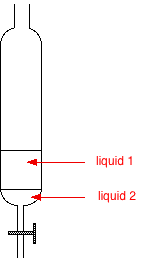|
Chemguide: Core Chemistry 14 - 16 Separating immiscible liquids This page introduces the terms miscible and immiscible, and shows how you can separate two immiscible liquids. Miscible and immiscible Two liquids are miscible if they will mix together to form a single uniform liquid. Water and alcohol are simple examples of miscible liquids. You can mix them in any proportions and still get a single liquid. Two liquids are immiscible if they don't mix, but instead form two separate layers. Water and petrol are simple examples. The petrol just forms a layer floating on the water. The less dense liquid floats on the more dense one. Simple separation You can separate immiscible liquids using a separating funnel.
You put the "mixture" into the separating funnel and allow them to settle to form two clean layers. Then you can run off the two layers separately into two beakers. If this was demonstrated to you, you would probably be shown some sort of oil which is mixed with water and then separated out into oil and water again using the separating funnel. And you might possibly think this is a rather pointless thing to do! In the real world, this sort of separation is often used in the lab to purify the product you get when you make an organic chemical. | |
|
Note: Organic chemistry is based on compounds containing chains or rings of carbon atoms with other things attached. Organic compounds are often immiscible with water. | |
|
Suppose, of example, that your organic product was contaminated with something acidic. Provided your product is immiscible with water, you can shake it with something which will react with the acid, but not your product. A solution of sodium carbonate in water is often used. After shaking, the acidic impurity reacts with the sodium carbonate solution producing substances which freely dissolve in the water. The water layer and the organic layer can be separated using a separating funnel.
© Jim Clark 2021 (modified May 2022) |
|
